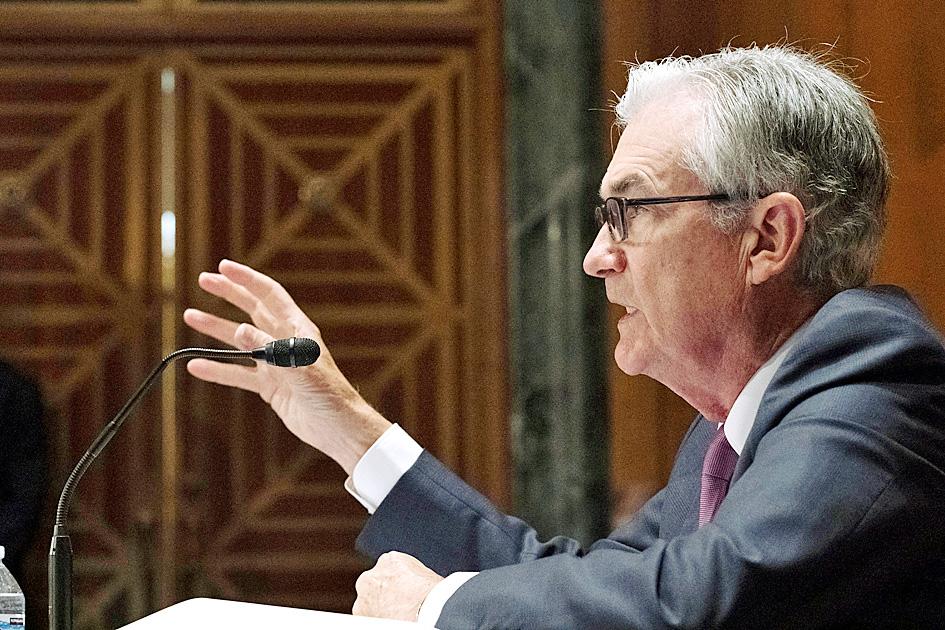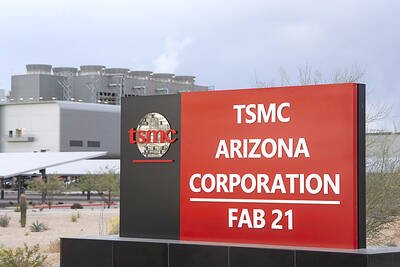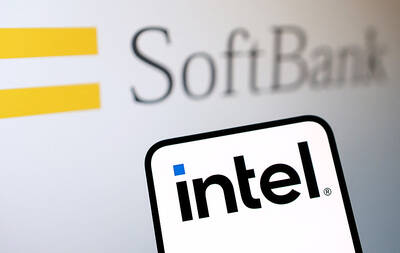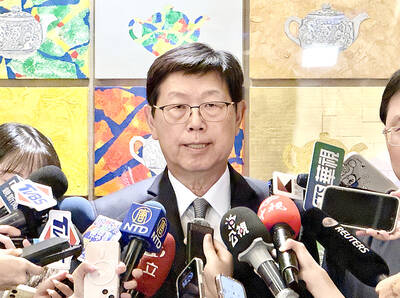Rising COVID-19 cases have slowed the US economy’s recovery, but the Federal Reserve on Wednesday said it might nonetheless “soon” be time to begin removing the stimulus it provided during the pandemic.
The closely watched announcement left policy unchanged for now, but new forecasts from central bankers show that they expect the first interest rate increase next year.
That would raise the benchmark lending rate above zero in the world’s dominant economy for the first time since the start of the pandemic.

Photo: AP
The economy has healed to the point that the central bank could slow the pace of purchases “if progress continues broadly as expected,” the policy-setting Federal Open Market Committee (FOMC) said in a statement after concluding its two-day meeting.
The Fed is juggling competing forces as rising prices fuel inflation concerns while the economy remains about 5 million jobs short of where it was before the pandemic struck, forcing widespread business closures.
Though US Federal Reserve Chair Jerome Powell again said that the central bank would not increase the key borrowing rate until later, rising inflation makes it more likely the bank could move sooner than expected.
In their quarterly forecasts, FOMC members boosted their inflation forecasts to a median of 4.2 percent for the year, even as they cut their growth outlook for next year to just 5.9 percent from the 7 percent projected in June.
More members of the committee now predict the first interest rate hike next year, and as many as three in 2023.
The FOMC still attributes the recent price pressures to “transitory factors,” and Powell said he expects the supply effect to “abate,” allowing inflation “to drop back toward the longer run goal” of 2 percent.
But the Fed chair acknowledged that there is an “upside risk” due to supply challenges and the shortage of workers.
“As the reopening continues, bottlenecks, hiring difficulties and other constraints can prove to be greater and longer-lasting than anticipated,” he told reporters after the committee’s meeting.
However, progress towards the Fed’s 2 percent inflation goal is “very much on track.”
The Fed is currently buying at least US$80 billion of Treasury securities and US$40 billion of mortgage-backed securities every month as part of its stimulus efforts.
Powell said that if the economy continues to improve, “a gradual tapering process that concludes around the middle of next year is likely to be appropriate.”
Asked if inflation concerns could lead the Fed to start raising interest rates before it had completed the taper, Powell said that it would not make sense.
“We can speed it up or slow it down as needed,” and pull back faster if inflation is too high, he said.
Analysts expect the taper to be announced at the FOMC’s next meeting in early November and begin in December, but Powell said some members would prefer to move sooner.
Grant Thornton LLP economist Diane Swonk said that Powell is holding the line as “a dove among the hawks,” with forecasts suggesting more central bankers “are concerned inflation will become a larger problem in 2022.”
Still, despite the downshift in the pace of the US recovery, policymakers remain relatively optimistic about the outlook.
“The sectors most adversely affected by the pandemic have improved in recent months, but the rise in COVID-19 cases has slowed their recovery,” the FOMC statement said, stressing that the bounce back is dependent on the course of the pandemic.

Taiwan Semiconductor Manufacturing Co (TSMC, 台積電), the world’s biggest contract chipmaker, booked its first-ever profit from its Arizona subsidiary in the first half of this year, four years after operations began, a company financial statement showed. Wholly owned by TSMC, the Arizona unit contributed NT$4.52 billion (US$150.1 million) in net profit, compared with a loss of NT$4.34 billion a year earlier, the statement showed. The company attributed the turnaround to strong market demand and high factory utilization. The Arizona unit counts Apple Inc, Nvidia Corp and Advanced Micro Devices Inc among its major customers. The firm’s first fab in Arizona began high-volume production

VOTE OF CONFIDENCE: The Japanese company is adding Intel to an investment portfolio that includes artificial intelligence linchpins Nvidia Corp and TSMC Softbank Group Corp agreed to buy US$2 billion of Intel Corp stock, a surprise deal to shore up a struggling US name while boosting its own chip ambitions. The Japanese company, which is adding Intel to an investment portfolio that includes artificial intelligence (AI) linchpins Nvidia Corp and Taiwan Semiconductor Manufacturing Co (TSMC, 台積電), is to pay US$23 a share — a small discount to Intel’s last close. Shares of the US chipmaker, which would issue new stock to Softbank, surged more than 5 percent in after-hours trading. Softbank’s stock fell as much as 5.4 percent on Tuesday in Tokyo, its

COLLABORATION: Softbank would supply manufacturing gear to the factory, and a joint venture would make AI data center equipment, Young Liu said Hon Hai Precision Industry Co (鴻海精密) would operate a US factory owned by Softbank Group Corp, setting up what is in the running to be the first manufacturing site in the Japanese company’s US$500 billion Stargate venture with OpenAI and Oracle Corp. Softbank is acquiring Hon Hai’s electric-vehicle plant in Ohio, but the Taiwanese company would continue to run the complex after turning it into an artificial intelligence (AI) server production plant, Hon Hai chairman Young Liu (劉揚偉) said yesterday. Softbank would supply manufacturing gear to the factory, and a joint venture between the two companies would make AI data

The Taiwan Automation Intelligence and Robot Show, which is to be held from Wednesday to Saturday at the Taipei Nangang Exhibition Center, would showcase the latest in artificial intelligence (AI)-driven robotics and automation technologies, the organizer said yesterday. The event would highlight applications in smart manufacturing, as well as information and communications technology, the Taiwan Automation Intelligence and Robotics Association said. More than 1,000 companies are to display innovations in semiconductors, electromechanics, industrial automation and intelligent manufacturing, it said in a news release. Visitors can explore automated guided vehicles, 3D machine vision systems and AI-powered applications at the show, along